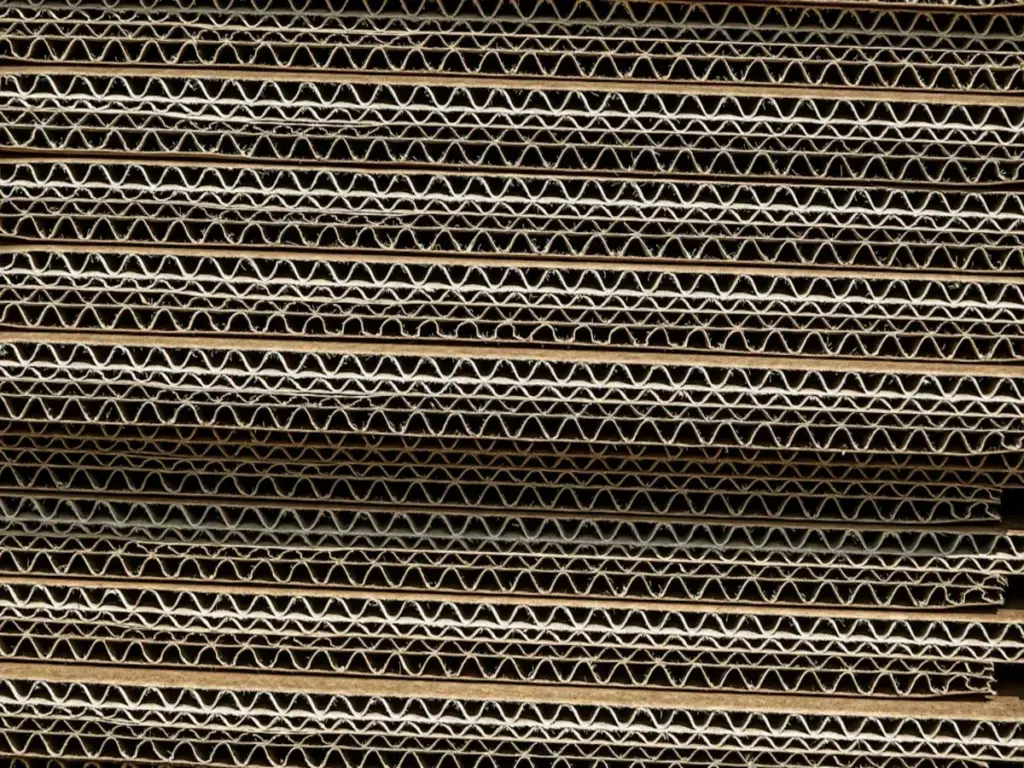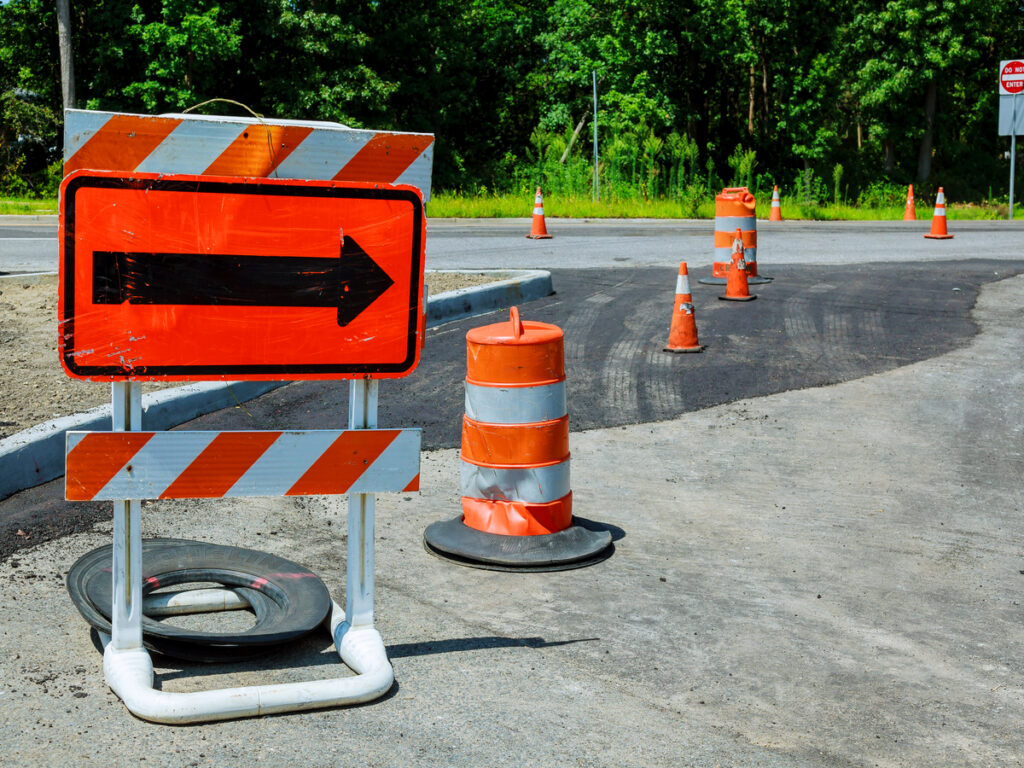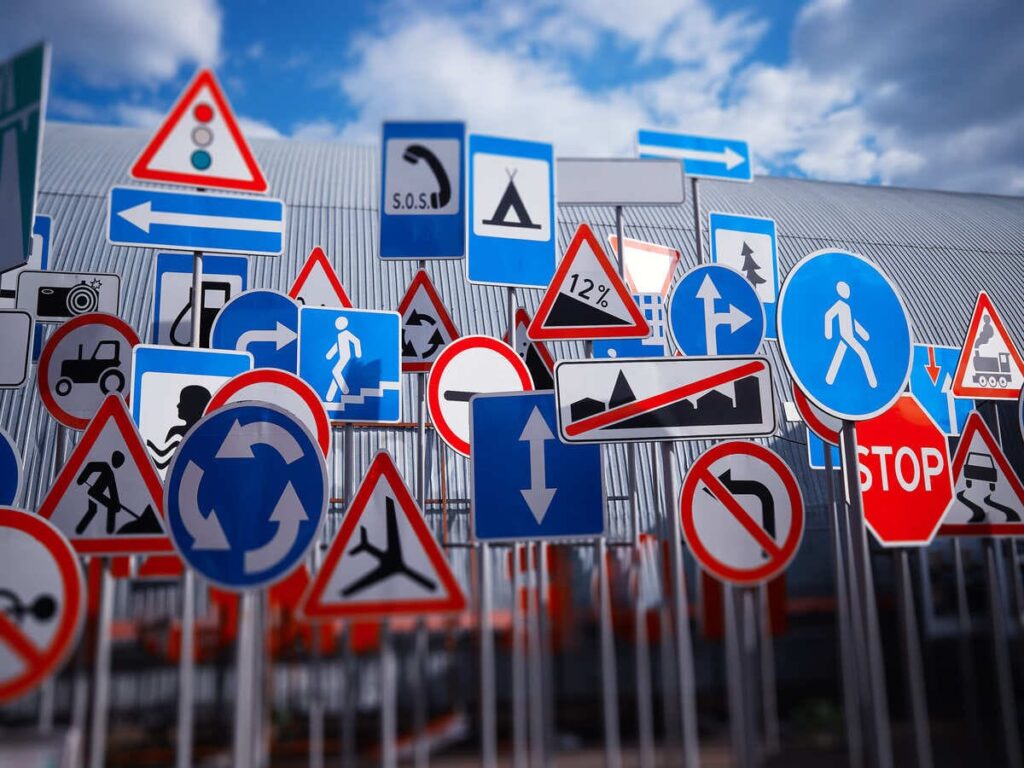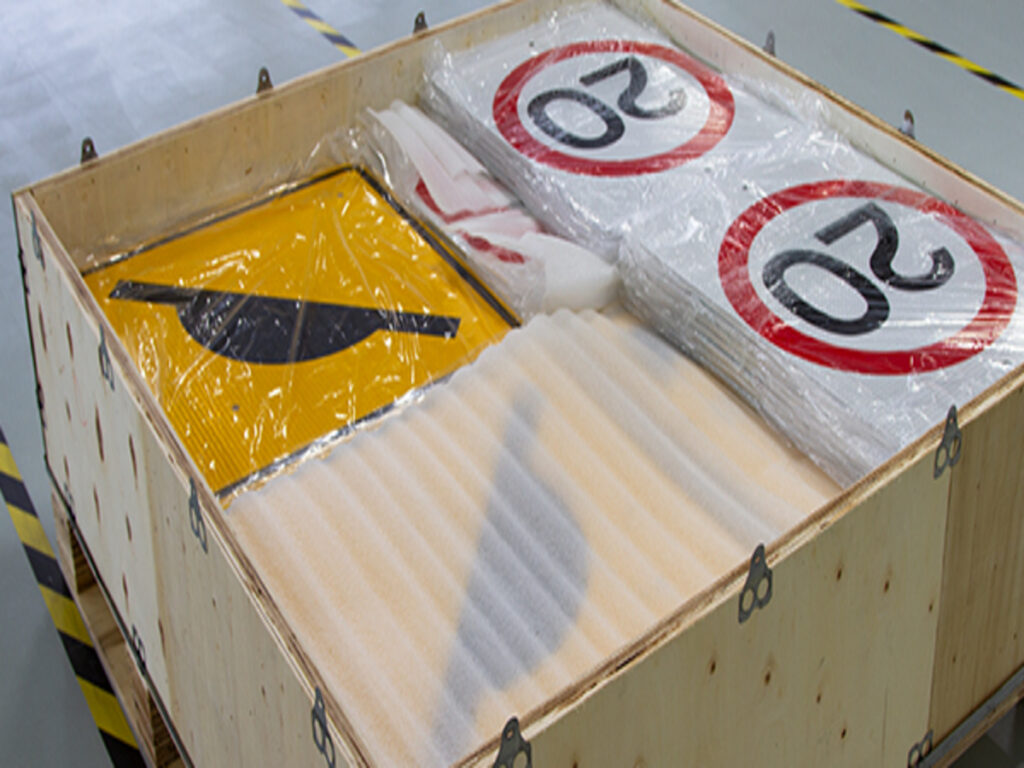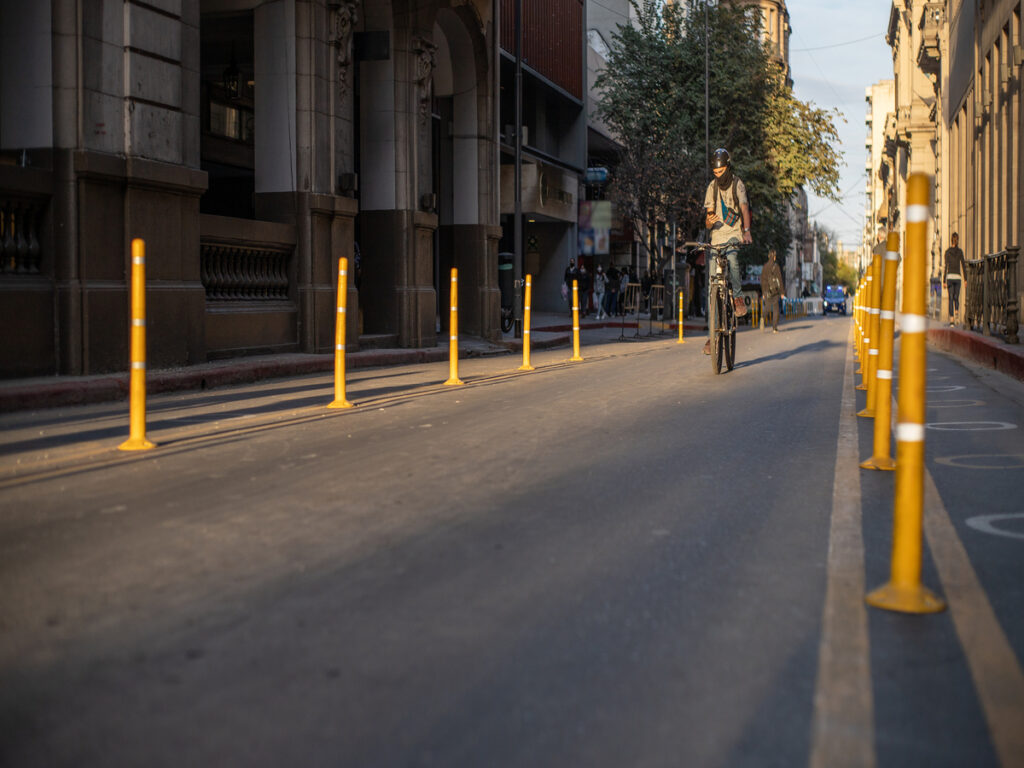
En la búsqueda de más seguridad, calles más organizadas, Los bolardos de control de tráfico son a menudo el eslabón perdido en las estrategias eficaces para calmar el tráfico.. Mientras que las medidas tradicionales, como los badenes y el estrechamiento de las carreteras, ayudan, Los bolardos proporcionan una solución versátil que no solo controla el tráfico sino que también mejora la seguridad y el diseño urbano.. Al colocar estratégicamente estos bolardos, Las ciudades pueden dirigir el movimiento de vehículos., proteger a los peatones, y crear un ambiente más atractivo y funcional. Las ciudades de América del Norte y Asia Pacífico están adoptando cada vez más bolardos de control de tráfico debido a su capacidad comprobada para reducir los accidentes y mejorar el flujo del tráfico.. Estas soluciones hacen más que simplemente detener los vehículos: moldean el comportamiento y brindan beneficios a largo plazo tanto para los conductores como para los peatones..
En Optraffic, proporcionamos bolardos de control de tráfico de alta calidad Con la confianza de numerosas empresas de gestión de tráfico en todo el mundo.. Nuestros bolardos de tráfico están diseñados para satisfacer las necesidades específicas de las ciudades que buscan mejorar la seguridad., reducir los accidentes, y mejorar el flujo de tráfico. con nuestro amplia experiencia y una base de clientes en crecimiento que incluye firmas líderes en gestión de tráfico, OPTRAFFIC se compromete a ayudar a las ciudades a crear entornos urbanos más seguros y eficientes..
Control de llave
- Los bolardos de control de tráfico mejoran la seguridad vial al guiar a los conductores, Protegiendo a los peatones, y calmar el tráfico sin medidas duras como badenes.
- Elegir el tipo de bolardo adecuado (flexible o rígido) depende de sus objetivos de seguridad, presupuesto, y necesidades de ubicación para una protección duradera y ahorro de costos.
- Colocación y diseño adecuados de bolardos., incluyendo altura, color, y patrones, ayudar a los conductores a notar los cambios y reducir la velocidad de manera efectiva.
- Combinando bolardos con bordillos, maceteros, letreros, y el estrechamiento de carriles crea, calles más atractivas que dan la bienvenida a todos.
- Planificación, aporte de la comunidad, y el monitoreo continuo garantizan que los bolardos funcionen bien, mantente accesible, y obtener apoyo público para espacios urbanos más seguros.
Redefinición de los bolardos de control de tráfico
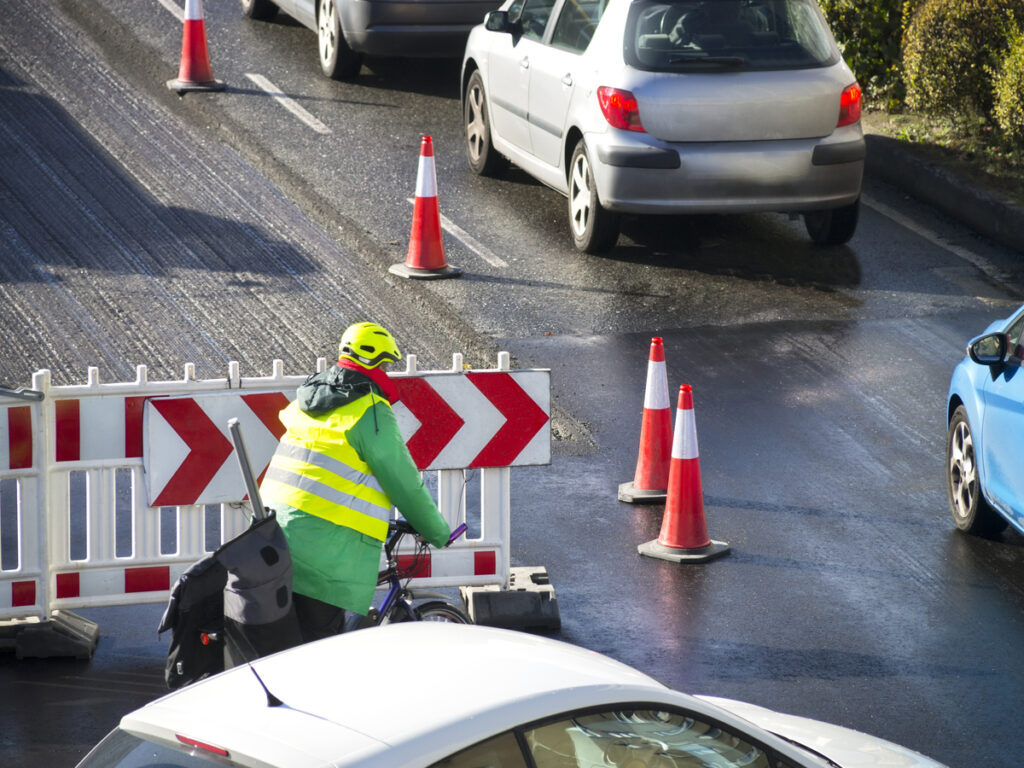
Funciones tradicionales
Puede pensar que los bolardos de tráfico son simples barreras.. En el pasado, las ciudades los usaban para impedir que los automóviles ingresaran a ciertas áreas o para proteger los edificios de choques accidentales. Estos puestos permanecían como guardias silenciosos., marcar límites y mantener los vehículos alejados de las aceras. Su trabajo principal era separar espacios y evitar daños.. Con el tiempo, Has visto estas publicaciones en rincones concurridos., frente a los escaparates, y en los bordes de las plazas. Funcionaron bien como divisores físicos., pero su papel permaneció limitado durante muchos años..
Calmando holístico del tráfico
Hoy, Puedes utilizar los bolardos de control de tráfico para mucho más que simplemente bloquear coches.. La planificación urbana moderna sitúa estas herramientas en el centro de las estrategias para calmar el tráfico.. Cuando agregas bolardos a tus calles, Creas caminos más seguros para las personas que caminan y andan en bicicleta.. También guías a los conductores para que reduzcan la velocidad y presten atención.. Ciudades de todo el mundo utilizan ahora bolardos para dar forma a la forma en que se mueve el tráfico, proteger los cruces peatonales, y hacer que los espacios públicos sean más atractivos. Puedes combinarlos con otros elementos como maceteros., bordillo, e iluminación para construir un sistema de seguridad completo. Este enfoque no sólo detiene a los coches.; transforma toda la calle en una más segura, lugar más acogedor para todos.
Consejo: Cuando planifica su plan maestro para calmar el tráfico, Piense en cómo los bolardos de control de tráfico pueden funcionar con otras características de seguridad.. Este trabajo en equipo crea una protección más fuerte y mejores resultados..
Comportamiento y seguridad del conductor
Quiere que los conductores reduzcan la velocidad y estén atentos a las personas que cruzan la calle.. Los bolardos de control de tráfico lo ayudan a lograr esto al cambiar la forma en que los conductores ven y usan la carretera.. Cuando colocas bolardos cerca de pasos de peatones y aceras, Los conductores notan el espacio más estrecho y están más alerta.. Los estudios muestran que agregar luces a los bolardos hace que los conductores sean más propensos a ceder el paso a los peatones, Especialmente por la noche. Una revisión realizada por el Centro de Investigación del Transporte de Luisiana encontró que los bolardos bien iluminados en los cruces peatonales reducen el riesgo de lesiones graves y muertes.. El Centro de Estudios de Transporte de la Universidad de Minnesota también señala que los bolardos brindan protección directa a las personas que caminan., Al igual que las señales de seguridad protegen a los conductores.. Los países que utilizan más bolardos y otras protecciones para peatones ven menos muertes de peatones que los lugares que no lo hacen. Grupos como Strong Towns incluso piden un uso generalizado de bolardos para mantener seguros a los usuarios vulnerables de la vía.. Ejemplos del mundo real, como el uso de bolardos en Ontario junto a los carriles de circulación, demuestran que estas publicaciones pueden cambiar el comportamiento de los conductores y mejorar la seguridad para todos.
Colocación y diseño de bolardo
Estrategias de colocación
Puedes controlar cómo se mueven los coches colocando bolardos en los lugares correctos. Colóquelos en los cruces peatonales para proteger a las personas que caminan.. Utilízalos en la entrada de los carriles bici para mantener alejados a los coches.. Colóquelos cerca de escuelas y parques para reducir la velocidad del tráfico.. Cuando configura bolardos de control de tráfico en un patrón, guías a los conductores y haces las calles más seguras. Intente utilizar un diseño escalonado para obligar a los coches a reducir la velocidad.. También puedes utilizar hileras de bolardos para bloquear atajos y mantener el tráfico en la carretera principal..
Consejo: Comprueba siempre cómo funcionan los coches., bicicleta, y la gente usa la calle antes de elegir dónde poner los bolardos. Esto le ayuda a obtener los mejores resultados..
Altura y señales visuales
La altura del bolardo importa. Los bolardos altos destacan y llaman la atención. Los más cortos se mezclan pero aún marcan el borde de un camino.. Utilice bolardos más altos donde quiera que los conductores noten un cambio., como en un nuevo paso de peatones. Mezcle alturas para crear una señal visual fuerte. Los colores brillantes y las tiras reflectantes hacen que los bolardos sean fáciles de ver, Incluso por la noche. Cuando usas estas señales visuales, ayudas a los conductores a reducir la velocidad y prestar atención.
Técnicas de reducción de velocidad
Puedes usar bolardos para frenar los autos sin agregar badenes. Colóquelos más juntos para que el camino parezca estrecho.. Los conductores reducirán la velocidad porque ven menos espacio. Intente utilizar un patrón en zigzag para dividir, caminos rectos. Esto hace que los conductores conduzcan con más cuidado.. Los bolardos elevados pueden señalar un lugar donde los automóviles deben detenerse o ceder el paso. Los bolardos bajados pueden mostrar un camino seguro para bicicletas o vehículos de emergencia. Con el diseño correcto, conviertes cualquier calle en un lugar más seguro para todos.
Flexible vs.. Bolardos Rígidos
Opciones flexibles
Quiere una solución que mantenga a las personas seguras pero que no dañe los vehículos. Los bolardos flexibles le brindan ese equilibrio. Estos postes se doblan cuando un auto los golpea, luego vuelve a su lugar. A menudo los ves fabricados con plásticos de alto impacto o poliuretano.. Funcionan bien en lugares donde es necesario guiar el tráfico pero no se quiere causar daño.. Utilice bolardos flexibles para eventos temporales, carriles para bicicletas, o áreas con patrones de tráfico cambiantes. Puedes moverlos o reemplazarlos fácilmente. También cuestan menos que las opciones rígidas., haciéndolos perfectos para proyectos con presupuestos ajustados.
Consejo: Elija bolardos flexibles para áreas donde espera un contacto frecuente con vehículos o necesita cambiar de diseño con frecuencia.
Opciones rígidas
Los bolardos rígidos le dan fuerza, protección permanente. Los ves hechos de acero., concreto, o incluso piedra. Estos postes de tráfico impiden que los coches entren en espacios donde camina o se reúne gente. Utilice bolardos rígidos frente a las escuelas, parque, o aceras concurridas. Resisten fuertes impactos y duran años.. Puedes elegir acabados como acero con recubrimiento en polvo u hormigón pulido para combinar con el estilo de tu ciudad.. Los bolardos rígidos envían un mensaje claro: "Aquí no se permiten vehículos". Mantienen seguros tus espacios más importantes.
Material y estética
La elección del material influye tanto en el funcionamiento como en el aspecto de los bolardos.. Aquí hay una guía rápida:
| Material | Impacto funcional | Impacto estético / Caso de uso típico |
|---|---|---|
| Acero | Alta resiliencia, resistencia al impacto, rentable | Versátil, Se puede terminar para una apariencia moderna o clásica. |
| Concreto | Durable, resistente al óxido, permanente | Aspecto sólido, ideal para parques y plazas |
| Aluminio | Ligero, resistente a la corrosión | Pulcro, Aspecto moderno para los centros urbanos. |
| Piedra o Mármol | Decorativo, protección media | Se adapta a espacios públicos históricos o especiales. |
| Madera | Ornamental | Sensación natural de los parques |
| Plásticos de alto impacto | Flexible, asequible, uso temporal | Bueno para orientación y control a corto plazo. |
| Poliuretano | Altamente elástico, resistente al impacto | Utilizado en bolardos flexibles para absorción de energía. |
También puedes elegir entre muchos colores., formas, y acabados. Agregue cinta reflectante o luces LED para una mejor visibilidad. Haga coincidir sus bolardos con el estilo de su ciudad o incluso agregue su logotipo para darle un toque personalizado.
Factores costo-beneficio
Quiere el mejor valor para su inversión. Los bolardos flexibles cuestan menos y funcionan bien para guiar el tráfico o marcar carriles. Ahorran dinero en reparaciones porque se doblan en lugar de romperse. Los bolardos rígidos cuestan más al principio, pero duran más y ofrecen una protección más fuerte.. Piensa en tus objetivos. Si necesitas detener los autos por completo, escoger bolardos rígidos. Si desea guiar el tráfico y mantener bajos los costos, las opciones flexibles funcionan mejor. Elija el tipo correcto para obtener la seguridad, estilo, y ahorro que tu ciudad necesita.
Integración de bolardos con otras medidas
Bolardos y Bordillos
Puede aumentar la seguridad combinando bolardos con bordillos. Esta combinación crea una fuerte barrera entre los coches y las personas.. Cuando coloca bolardos de control de tráfico junto a las aceras, alejas los vehículos de las aceras y los pasos de peatones. Los conductores ven un borde claro y saben dónde detenerse. Proteges a los niños cerca de las escuelas y a las familias en los parques. Muchas ciudades utilizan este método para mantener las calles concurridas seguras y organizadas..
Jardineras y diseño ecológico.
Quieres que tus calles luzcan hermosas y se sientan seguras. Agregue maceteros junto a los bolardos para darle un toque verde. Las plantas suavizan el aspecto de los postes y hacen que los espacios públicos sean más atractivos.. Puedes usar maceteros grandes para bloquear los autos y al mismo tiempo darle a la gente un lugar para descansar o disfrutar de las flores.. Este diseño funciona bien en plazas., áreas de compras, y calles estilo zona residencial. El holandés woonerf muestra cómo mezclar plantas, caminos sinuosos, y bolardos crean una calma, espacio compartido para todos.
Señalización y Marcadores
Claro letreros de tráfico y los marcadores ayudan a los conductores a comprender las nuevas reglas. Coloque señales cerca de bolardos para mostrar los límites de velocidad o marcar zonas peatonales.. Utilice cinta reflectante o pintura en los bolardos para mejorar la visibilidad durante la noche.. When you combine traffic control bollards with signs, you send a strong message. Drivers slow down and pay attention. Pedestrians feel safer crossing the street.
Road Diets and Lane Narrowing
You can slow traffic by narrowing lanes and adding bollards. This method, llamado dieta de carretera, reduces the number of driving lanes and gives more space to people walking or biking. Place bollards along the new edge to guide cars and protect bike lanes. Urban planners in the Netherlands use this approach with chicanes, bulb-outs, and raised crosswalks. You get safer streets and fewer accidents. Try this strategy to transform busy roads into people-friendly spaces.
Behavioral Impact and Case Studies
Psychological Effects
You want drivers to pay attention and make safer choices. Los bolardos de control de tráfico le ayudan a lograrlo cambiando la forma en que los conductores piensan y actúan al volante.. Cuando agregas bolardos a las calles de la ciudad, Creas una sensación de orden y concentración.. Los conductores ven un camino despejado y saben adónde ir. En un experimento de conducción simulada, Los investigadores descubrieron que los bolardos elásticos mejoraban la precisión del cambio de carril.. Los conductores sintieron menos estrés mental y tomaron mejores decisiones. Los datos de seguimiento ocular mostraron que los conductores miraban la carretera con más atención cuando había bolardos presentes. Estos resultados demuestran que los bolardos hacen más que bloquear los automóviles: guían a los conductores para que actúen de manera segura..
- Un experimento de conducción simulada con 30 Los participantes demostraron que los bolardos elásticos mejoraban la precisión del cambio de carril..
- Las puntuaciones de seguimiento ocular y carga de trabajo revelaron que los conductores prestaron más atención y sintieron menos estrés..
- Los bolardos superaron a otros métodos de guía visual para ayudar a los conductores a mantener el rumbo..
Zonas Peatonales
Puede hacer las zonas peatonales más seguras y más acogedor con la configuración adecuada del bolardo. Cuando instala bolardos, ayudas a los conductores a notar los cruces de peatones y reducir la velocidad. La gente se siente más segura caminando, y los conductores paran más a menudo cuando cruzan la calle. Los números hablan por sí mismos:
| Resultado medido | Antes de la instalación | Después de la instalación | Notas/Detalles |
|---|---|---|---|
| Los conductores se detienen ante los peatones. | 67% | 82% | Instalación de bolardo de infrarrojos en el Ayuntamiento |
| Peatones corriendo para completar/abortar el cruce | 6% | 3% | Instalación de bolardo de infrarrojos en el Ayuntamiento |
| Precisión de detección de peatones (bolardos infrarrojos) | N / A | 91-94% | Tasa de detección correcta |
| Tasa de activación falsa (bolardos infrarrojos) | N / A | 2-9% | Falsas activaciones |
| Los conductores se detienen ante los peatones. (detección de microondas) | 53% | 72% | Ubicaciones de detección de microondas combinadas |
| Peatones corriendo para completar/abortar el cruce (detección de microondas) | 2% | 5% | Ubicaciones de detección de microondas combinadas |
| Actitudes de los peatones (utilidad percibida) | N / A | 50% | de aquellos conscientes, Las luces encontradas son "muy útiles" |
| Actitudes de los peatones (conductor percibido cediendo) | N / A | 73% | Los conductores creídos cedieron el paso con mayor frecuencia |
| Peatones que terminan en Red Hand sólido (peatones videntes) | 27% | 17% | Después de la instalación de señales peatonales accesibles (APS) |
| Peatones iniciando fase de Caminata (peatones videntes) | 59% | 70% | Después de la instalación de APS |
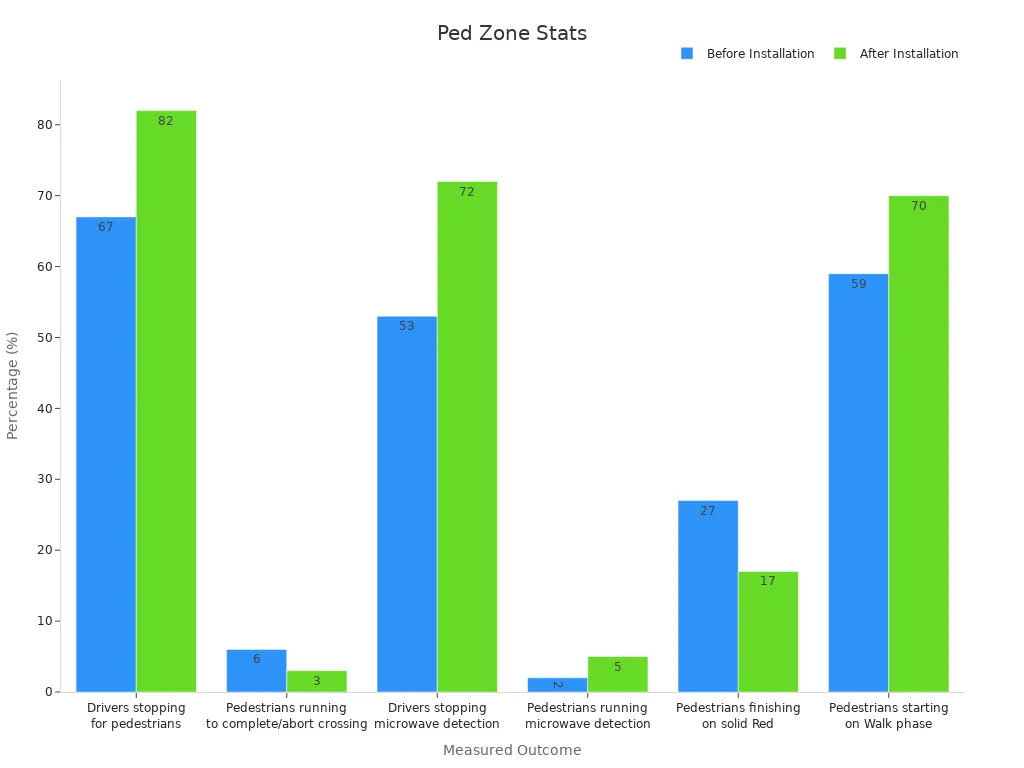
Estudios de caso
Puedes ver el impacto real de los bolardos en ciudades de todo el mundo. En una ciudad, después de instalar bolardos infrarrojos en los pasos de peatones, el número de conductores que se detienen ante peatones aumentó de 67% a 82%. Menos personas tuvieron que correr para terminar de cruzar. en otro lugar, Los bolardos de detección de microondas ayudaron a que más conductores cedieran el paso y hicieron que los peatones se sintieran más seguros.. Estos resultados muestran que cuando se utilizan bolardos de control de tráfico, creas calles donde todos se sienten protegidos. Ayuda a los conductores a tomar mejores decisiones y brinda a los peatones la confianza para caminar con seguridad.
Planificación y desafíos

Evaluación de tráfico
Necesita un plan claro antes de instalar bolardos de control de tráfico. Comience recopilando datos sobre la ubicación de su proyecto. Mira el volumen de tráfico, velocidad, y cómo se mueven los coches y las personas. Usa cámaras, sensores, y GPS para rastrear el flujo en tiempo real. Estudie los informes de accidentes para encontrar puntos peligrosos. Próximo, Utilice el software CAD para crear un modelo de su calle.. Agregar carriles, intersecciones, pasarelas, y bolardos. Revise su diseño con los equipos de la ciudad y ajústelo según sea necesario. Este proceso le ayuda a colocar bolardos en los mejores lugares y mantiene su plan flexible a medida que cambian las condiciones..
Previsibilidad y cumplimiento
Quieres que los conductores sigan las reglas, pero también quieres mantenerlos alerta. Los bolardos extraíbles y resistentes a accidentes le permiten cambiar los patrones de tráfico. Por ejemplo, puedes bloquear diferentes carriles en diferentes días o configurar chicanes durante las horas punta. Esto hace que el tráfico sea menos predecible y ayuda a prevenir la conducción insegura.. La colocación dinámica de bolardos también puede aumentar la seguridad al detener vehículos no deseados..
Colaboración comunitaria
Obtienes mejores resultados cuando trabajas con tu comunidad. Habla con grupos locales, funcionarios de la ciudad, y dueños de negocios. Solicite comentarios sobre sus planes de bolardos. Escuche las preocupaciones sobre el espacio en las aceras, vendedores ambulantes, y accesibilidad. Cuando incluyes a todos, generas confianza y creas un ambiente más seguro, calle más acogedora.
Monitoreo y Evaluación
Después de instalar bolardos, sigue comprobando cómo funcionan. Utilice cámaras y sensores para observar el flujo de tráfico. Recoger comentarios de las personas que utilizan la calle.. Actualice sus modelos CAD a medida que las cosas cambien. Esto le ayuda a detectar problemas a tiempo y realizar mejoras..
Seguridad y Accesibilidad
Quieres que todos se sientan seguros. Asegúrese de que el espacio entre los bolardos permita el paso de sillas de ruedas y cochecitos.. Siga los estándares de la ADA para caminos despejados. Colocar bolardos donde protejan a las personas pero no bloqueen el movimiento.. Un buen diseño mantiene las calles abiertas y seguras para todos.
Mantenimiento y durabilidad
Elija bolardos que duren. Elija materiales que resistan el clima y los impactos.. Planifique controles periódicos y reparaciones rápidas. Los bolardos flexibles funcionan bien en áreas concurridas porque se doblan y retroceden. Los bolardos rígidos ofrecen una fuerte, protección a largo plazo.
Aceptación pública
A la gente le importa cómo se ven y se sienten las calles. A algunos les preocupa que los bolardos hagan que las aceras estén llenas de gente o sean menos atractivas.. A otros les gusta el extra de seguridad y orden.. En la ciudad de Nueva York, funcionarios y proveedores compartieron opiniones encontradas sobre la colocación de bolardos. Puedes aumentar la aceptación eligiendo diseños que se ajusten al estilo de tu ciudad y escuchando los comentarios del público..
Acceso de emergencia
Planifique siempre para los vehículos de emergencia. Utilice bolardos extraíbles o plegables en puntos clave. Asegúrese de que los camiones de bomberos y las ambulancias puedan llegar rápidamente a todas las zonas.. Una buena planificación mantiene a todos seguros en caso de emergencia.
Puedes transformar tu ciudad con bolardos de control de tráfico. Ciudades como Nueva York, Londres, y Ámsterdam los utilizan para proteger a las personas, Administrar tráfico, y mantener las calles hermosas. Los expertos coinciden en que estas soluciones aumentan la seguridad y ayudan a las comunidades a prosperar.
| Ciudad | Ejemplo de impacto |
|---|---|
| Nueva York | Times Square protegido con bolardos de acero |
| Amsterdam | Bolardos retráctiles usados para carriles bici más seguros |
| Singapur | Los bolardos inteligentes crean zonas flexibles sin coches |
Comience a planificar hoy. Haz tus calles más seguras, más inteligente, y más acogedor para todos.
Preguntas frecuentes
¿Qué hace que los bolardos de control de tráfico sean mejores que los badenes??
Obtienes calles más seguras sin el ruido o la incomodidad de golpes de velocidad. Los bolardos ralentizan los coches cambiando la forma en que los conductores ven la carretera. Protege a los peatones y mantiene el tráfico fluido. Elija bolardos para un estilo moderno, solución efectiva.
¿Se pueden utilizar bolardos en todas las condiciones climáticas??
Sí! Puede confiar en los bolardos durante todo el año. La mayoría de los bolardos resisten la lluvia, nieve, y sol. Elija materiales como acero o poliuretano para mayor durabilidad.. Mantienes tus calles seguras sin importar la temporada..
¿Cómo se elige entre bolardos flexibles y rígidos??
Piensa en tus objetivos. Utilice bolardos flexibles donde los coches puedan golpearlos con frecuencia.. Elija bolardos rígidos para obtener, barreras permanentes. Ahorra dinero y aumenta la seguridad adaptando el tipo de bolardo a sus necesidades.
¿Los bolardos bloquearán los vehículos de emergencia??
No. Puedes instalar bolardos desmontables o plegables en puntos clave. Los equipos de emergencia obtienen acceso rápido cuando es necesario. Mantienes a todos seguros y nunca ralentizas a los socorristas..
¿Los bolardos mejoran el aspecto de tu calle??
Absolutamente! Puedes elegir colores, formas, y acabados que combinan con el estilo de tu ciudad. Agregue maceteros o luces para darle más atractivo. Los bolardos hacen que sus calles sean más seguras y atractivas al mismo tiempo.


